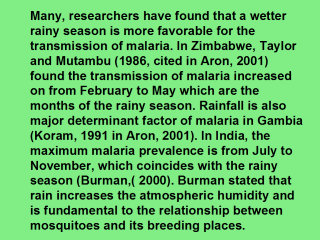 |
The intensive
rainfall is considered an important factor of the transport of pathogenic
micro-organism, including malaria parasites. Conversely, drought caused by
the drop of annual rainfall over a 30-year interval was associated with the
decrease of parasite index in children in Senegal, Africa (Faye, 1995 cited
in Hong, 1998). So it is clear that the duration of rainy and dry seasons
and the interval of those seasons affect larvae and adult vector development
and abundance (Patz, 2000).
The difference between malaria patterns at District level and at the village
level may be due to many factors. Firstly, :malaria was distributed unevenly
within the villages. Secondly, the data points that were collected in health
center were insufficient to give a complete description of malaria
prevalence in the villages. Thirdly, malaria is influenced by local specific
conditions. However, in this district, the areas of endemic malaria are very
wide with much variability. Thus, it was very difficult to have a clear
pattern of malaria transmission without a good monitoring system. In Africa,
the scarcity of basic data and the lack of understanding malaria situation
is one of the enormous problems in malaria control program (MARA, 2001).
|
